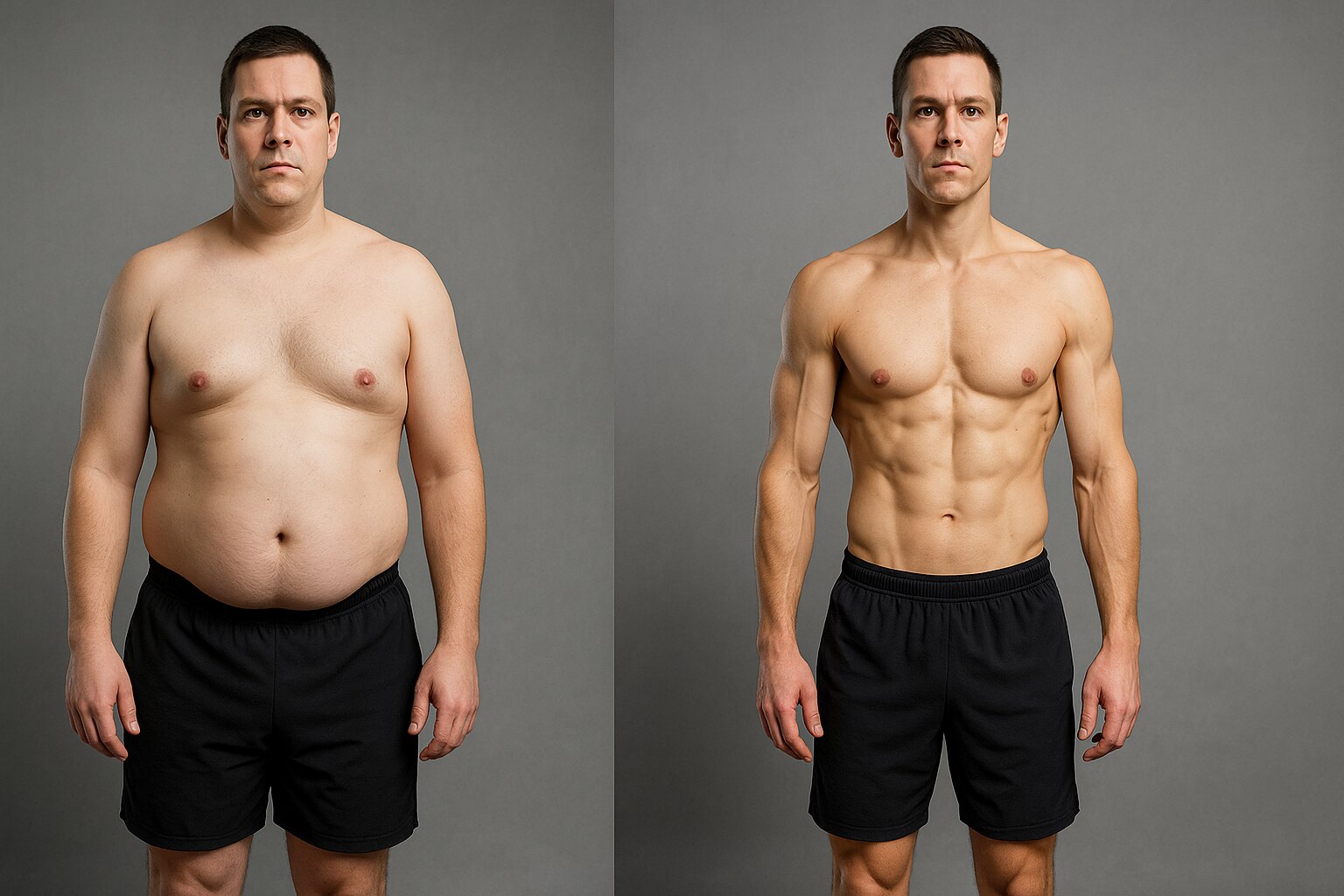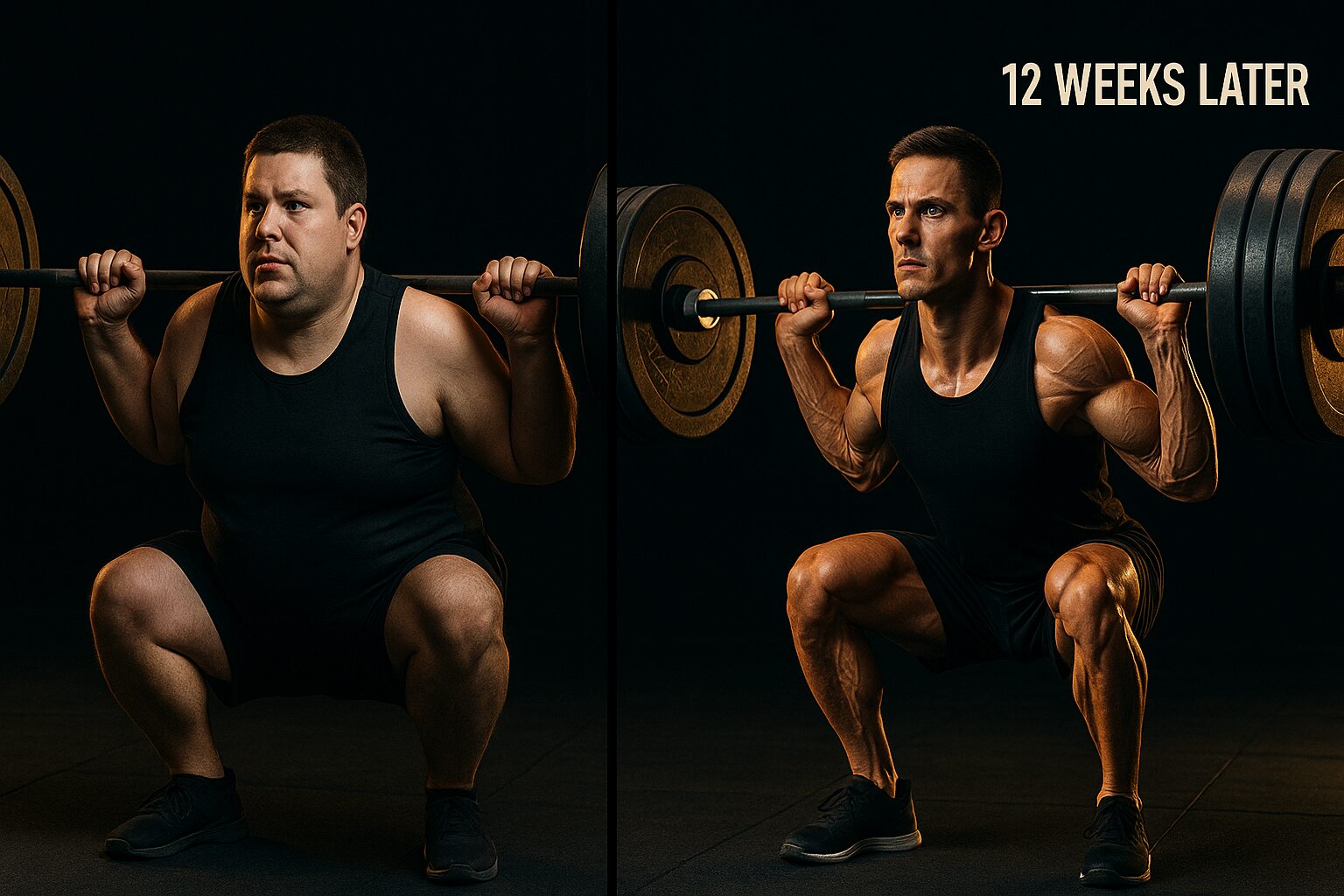Raggiungere una corporatura snella e muscolosa è un obiettivo comune di fitness, ma perdere grasso mantenendo la massa muscolare guadagnata con fatica richiede un approccio strategico. La sfida sta nel creare le giuste condizioni per la perdita di grasso senza provocare la degradazione muscolare—un equilibrio delicato che la scienza può aiutarci a comprendere e raggiungere.

Questa guida completa ti guiderà attraverso strategie basate su evidenze per perdere grasso corporeo mantenendo forza e massa muscolare. Che tu stia preparando una competizione di fitness o semplicemente voglia apparire e sentirti al meglio, comprendere questi principi ti aiuterà a ottenere risultati sostenibili.
Comprendere la ricomposizione corporea
La ricomposizione corporea—perdere grasso e allo stesso tempo preservare o addirittura costruire muscoli—è possibile con l’approccio giusto. Le ricerche dimostrano che la chiave risiede in tre principi fondamentali: mantenere un apporto proteico adeguato, seguire un deficit calorico moderato e praticare regolarmente allenamento di resistenza.
Il processo non riguarda solo l’estetica. Quando si perde peso, oltre il 25% del peso totale perso tipicamente deriva dalla massa priva di grassi, inclusa la massa muscolare scheletrica. Questa perdita muscolare può compromettere la salute metabolica, ridurre la funzione fisica e persino aumentare il rischio di un ritorno di peso in futuro.

Perché la conservazione muscolare è importante
Il tessuto muscolare svolge ruoli cruciali oltre l’aspetto:
Funzione metabolica: Il muscolo è tessuto metabolicamente attivo che brucia calorie anche a riposo. Il tuo speso energetico a riposo—le calorie che il corpo brucia senza fare nulla—rappresenta circa due terzi del tuo totale dipendimento energetico giornaliero. Quando perdi muscoli, il metabolismo diminuisce, rendendo più difficile mantenere la perdita di peso nel tempo.
Sensibilità all’insulina: Il muscolo gestisce oltre il 75% dell’eliminazione del glucosio mediato dall’insulina, quindi perdere massa muscolare può aumentare la resistenza all’insulina, un fattore di rischio per il diabete.
Funzione fisica: Mantenere la massa muscolare supporta mobilità, forza e indipendenza, soprattutto con l’età. La perdita di massa muscolare può ridurre la forza e aumentare il rischio di cadute di circa il 20% ogni 15% di riduzione della forza della parte inferiore delle gambe.
Il giusto deficit calorico
Creare un deficit calorico è necessario per la perdita di grasso: devi bruciare più calorie di quante ne consumi. Tuttavia, la dimensione di quel deficit è molto importante.
Trovare il tuo punto giusto
Si raccomanda un deficit calorico moderato di 300-500 calorie sotto il mantenimento. Questo permette una perdita costante di grasso fornendo al contempo sufficiente energia per sostenere il mantenimento muscolare e il recupero.
Linee guida sul deficit per obiettivo:
- Standard approach: 500 calories per day (approximately 1 pound per week of fat loss)
- Conservative approach: 250-300 calories per day (better for leaner individuals)
- Aggressive approach: 750 calories per day (only for those with higher body fat percentages)
Perdere più di 1 chilogrammo (2,2 libbre) a settimana spesso porta a una significativa perdita di massa muscolare, con studi che indicano che circa il 20% del peso perso può coinvolgere muscoli durante diete estreme.
La chiave è la pazienza. Una perdita di peso rapida può sembrare allettante, ma spesso porta alla perdita sia di grasso che di muscoli. Un approccio più lento e controllato assicura che il peso che si perde derivi principalmente dalle riserve di grasso.
Proteine: il miglior amico del tuo muscolo
L’assunzione di proteine diventa ancora più critica durante la fase di perdita di grasso. Quando sei in deficit calorico, il tuo corpo ha bisogno di abbastanza proteine per prevenire la degradazione muscolare.

Quante proteine ti servono?
La ricerca supporta un’assunzione proteica di 1,6-2,2 grammi per chilogrammo di peso corporeo per una conservazione ottimale dei muscoli durante la perdita di grasso. Per chi usa libbre, questo si traduce in circa 0,7-1,0 grammi per libbra di peso corporeo.
Perché più proteine durante un taglio?
Le proteine svolgono molteplici scopi durante la perdita di grasso:
- Preserves muscle tissue when calories are restricted
- Has a high thermic effect (your body burns calories digesting it)
- Increases satiety, helping you feel fuller longer
- Supports recovery from training
Uno studio fondamentale ha rilevato che, durante un marcato deficit energetico, il consumo di una dieta contenente 2,4 grammi di proteine per chilogrammo al giorno è stato più efficace di 1,2 grammi per chilogrammo al giorno nel promuovere l’aumento della massa magra e la perdita di massa grassa combinati con l’esercizio fisico.
La distribuzione delle proteine conta
Non concentrarti solo sulla proteina totale giornaliera—conta anche come le distribuisci durante la giornata. Si consiglia di consumare tra i 25 e i 40 grammi di proteine a ogni pasto per massimizzare il recupero e la sintesi proteica muscolare.
Le migliori fonti proteiche:
- Lean meats (chicken, turkey, lean beef)
- Fish and seafood
- Eggs and egg whites
- Greek yogurt and cottage cheese
- Legumes and beans
- Protein supplements (whey, casein, plant-based)
Allenamento di Resistenza: Il Non Negoziabile
Se c’è un fattore che determina se perdere grasso o muscolo durante un deficit calorico, è l’allenamento con i pesi. L’allenamento di forza invia un segnale potente al tuo corpo che il muscolo è necessario e deve essere preservato.
La scienza dell’allenamento durante la perdita di grasso
Una revisione completa del 2024 sottolinea che l’allenamento con la resistenza previene la perdita muscolare indotta dalla restrizione energetica attraverso diversi meccanismi. Quando sollevi pesi, crei micro-lacerazioni nelle fibre muscolari che il tuo corpo poi ripara e rafforza—ma solo se fornisci adeguati stimoli e nutrizione.
Parametri ottimali di addestramento
Frequenza: 3-4 sessioni di allenamento con i pesi a settimana
Volume: 10-20 serie per gruppo muscolare a settimana
Intensità: 65-80% del massimo 1 ripetizione (circa 8-12 ripetizioni per serie)
Riposo: 2-3 minuti tra i movimenti composti, 1-2 minuti per gli esercizi di isolamento
Aggiustamenti dell’allenamento per la perdita di grasso
Quando tagli, probabilmente avrai meno energia rispetto alle fasi di mantenimento o di massa. Ecco come regolare:
Mantieni l’intensità, regola il volume se necessario: Continua a sollevare abbastanza pesanti da stimolare i muscoli, ma potresti dover ridurre il totale delle serie se il recupero diventa un problema.
Dai priorità ai movimenti composti: Esercizi come squat, stacchi, panca piana e canottaggio lavorano contemporaneamente più gruppi muscolari, fornendo più stimoli con meno volume totale.
Routine a corpo intero vs. split: Ricerche emergenti del 2024 suggeriscono un potenziale vantaggio per le routine a corpo intero nel promuovere la perdita di grasso, poiché i partecipanti ad allenamenti per tutto il corpo hanno registrato una maggiore perdita di massa grassa rispetto a quelli che utilizzano le routine tradizionali di split sheet.
Cardio: Supportare la perdita di grasso senza esagerare
L’esercizio cardiovascolare può favorire la perdita di grasso aumentando il tuo consumo energetico giornaliero totale. Tuttavia, il tipo e la quantità di cardio sono importanti.
Allenamento a intervalli ad alta intensità (HIIT)
L’HIIT si basa più sul grasso immagazzinato per il carburante che sulla decomposizione muscolare, e l’effetto postbruciatura mantiene il metabolismo elevato per ore dopo l’allenamento. Bastano 20-30 minuti di HIIT 2-3 volte a settimana possono essere molto efficaci.
Cardio a Stato Stabiliario
Si può aggiungere cardio di intensità moderata (camminata, jogging, ciclismo) per bruciare calorie aggiuntive senza compromettere significativamente il recupero. Punta a 2-3 sessioni a settimana di 30-45 minuti.
Importante: Troppo cardio, soprattutto se combinato con un deficit calorico aggressivo, può portare a una perdita muscolare. Trova la dose minima efficace che supporti i tuoi obiettivi di perdita di grasso senza compromettere il recupero.

Sonno e recupero: i fattori nascosti
Un sonno di qualità è forse la componente più sottovalutata per una ricomposizione corporea di successo. Durante il sonno, il tuo corpo rilascia ormone della crescita e ripara il tessuto muscolare. La privazione cronica del sonno può:
- Increase cortisol (a stress hormone that promotes muscle breakdown)
- Reduce testosterone and growth hormone
- Impair insulin sensitivity
- Increase hunger and cravings
Punta a 7-9 ore di sonno di qualità a notte per ottimizzare la conservazione muscolare e la perdita di grasso.
Monitorare i progressi nel modo giusto
La bilancia non racconta tutta la storia. Quando si perde grasso mantenendo la massa muscolare, è necessario monitorare più metriche:
Misurazioni della composizione corporea: Utilizzare metodi come scansioni DEXA, impedenza bioelettrica o anche semplici foto e misurazioni di progresso
Prestazioni in palestra: Se mantieni o aumenti la forza, probabilmente stai preservando la muscolatura
Pesature settimanali: Monitora le tendenze del peso nel tempo, ma non ossessionarti sulle fluttuazioni quotidiane
Tasso di perdita: Punta a uno 0,5-1% di peso corporeo a settimana per una perdita ottimale di grasso con la conservazione muscolare
Errori comuni da evitare
Tagliare le calorie in modo troppo aggressivo: Questo provoca una perdita muscolare eccessiva e un adattamento metabolico
Trascurare l’assunzione proteica: Senza proteine adeguate, la degradazione muscolare è inevitabile
Salto l’allenamento di resistenza: Il cardio da solo non preserva i muscoli durante la perdita di grasso
Non si adatta man mano che si procede: Il fabbisogno calorico diminuisce man mano che perdi peso—rivaluta ogni 2-4 settimane
Affrettare il processo: La perdita di grasso sostenibile richiede tempo; aspettarsi risultati rapidi porta alla perdita muscolare
Giornata di esempio: mettere insieme tutto
Ecco come potrebbe essere una giornata efficace per la perdita di grasso:

Mattina:
- Resistance training session (45-60 minutes)
- Post-workout meal with 30-40g protein
Mezzogiorno:
- Protein-rich lunch with vegetables and moderate carbs
- Light activity (walking)
Pomeriggio:
- Protein snack if needed
Sera:
- Balanced dinner with lean protein, vegetables, and healthy fats
- Optional: Light cardio or rest day recovery
Prima di andare a letto:
- Casein protein or Greek yogurt for overnight muscle protein synthesis
Considerazioni Speciali
Per principianti
Se sei nuovo all’allenamento (meno di 6 mesi di sollevamento costante), sei in una posizione vantaggiosa. I nuovi sollevatori che si allenano due volte a settimana e consumano circa 0,5 grammi per libbra al giorno possono effettivamente aumentare muscolo anche in deficit calorico.
Per sollevatori avanzati
Più sei allenato, più diventa fondamentale perfezionare la nutrizione e l’allenamento. I sollevatori esperti devono essere più conservatori con i loro deficit calorici e possono trarre beneficio da pause dietetiche per preservare il metabolismo.
Per gli adulti anziani
Le ricerche dimostrano che combinare l’esercizio di resistenza con l’integrazione proteica durante una restrizione calorica moderata ha dimostrato efficacia nel preservare la massa magra durante la perdita di peso negli anziani con obesità. Gli individui anziani possono aver bisogno di un apporto proteico leggermente più elevato a causa della diminuta sensibilità agli amminoacidi.
Supporto di integrazione
Anche se gli integratori non sono obbligatori, alcuni possono supportare i tuoi obiettivi:
Polvere proteica: Modo comodo per raggiungere i bersagli proteiciCreatina monoidrata: Supporta la forza e la ritenzione muscolareCaffeina: Può migliorare le prestazioni di allenamento e l’ossidazione dei grassiMultivitaminico: Aiuta a colmare le lacune nutrizionali durante la restrizione calorica
La conclusione
Perdere grasso senza perdere muscolo è del tutto possibile con il giusto approccio. La formula è semplice ma richiede coerenza:
- Create a moderate caloric deficit (300-500 calories)
- Eat adequate protein (1.6-2.2g per kg body weight)
- Maintain resistance training (3-4x per week)
- Add strategic cardio (2-3x per week)
- Prioritize sleep and recovery
- Track progress beyond just the scale
- Be patient—sustainable results take time
Ricorda che la conservazione del muscolo durante la perdita di grasso non riguarda la perfezione, ma l’applicazione costante di principi basati su evidenze nel tempo. Concentrandoti su queste contromisure fondamentali, puoi ottenere una perdita di peso efficace attraverso la riduzione del tessuto adiposo, preservando la massa muscolare scheletrica, migliorando i risultati di salute e la funzionalità a lungo termine.
Il percorso verso una corporatura snella e muscolosa richiede dedizione, ma armato di questo approccio basato sulla scienza, sei preparato a raggiungere i tuoi obiettivi mantenendo i muscoli che hai costruito con fatica.
Fonti:
- Journal of the Endocrine Society (2024)
- Metabolism: Clinical and Experimental (2024)
- The Lancet Diabetes & Endocrinology (2024)
- American Journal of Clinical Nutrition
- Nutrients Journal
- Pennington Biomedical Research Center
- Lifestyle Medicine (Wiley Online Library)
- Various peer-reviewed sports nutrition and exercise science journals


